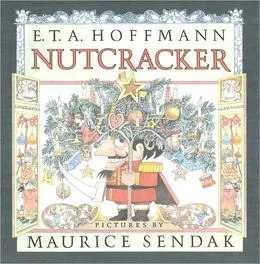While we were in South Carolina visiting the cousins, we were so lucky to have the opportunity to attend the Dickens’ Christmas Festival and see our cousin perform in the window as a mouse from the classic Nutcracker. It’s a holiday classic that seems to add magic to the holidays!
E.T.A. Hoffmann, author of NUTCRACKER, with illustrations by Maurice Sendak and translated by Ralph Manheim, is a book sure to rekindle magic time and time again. This book has recently been reissued following Sendak’s death and on the 50th anniversary of Where the Wild Things Are. It is a lush and beautifully illustrated edition, perfect for the entire family, and serves as a wonderful tribute to his life at a time when his legions of fans worldwide are honoring his legacy and ballets are performing their own versions of this timeless classic. Called “a classic, new and complete” by the New York Times Book Review, Sendak’s NUTCRACKER (On Sale October 30, 2012)brings to life E.T.A. Hoffmann’s mysterious world with his extraordinary illustrations, and this stunning reissue will be published just in time for the holidays.
Ernst Theodor Amadeus Hoffmann
E.T.A. Hoffmann, born Ernst Theodor Amadeus Hoffmann on January 24, 1776, was a German Romantic author and composer. He is best known for his fantastical and often dark short stories and novels. One of his most famous works is “The Nutcracker and the Mouse King,” which was written in 1816.
E.T.A. Hoffman’s Nutcracker
E.T.A. Hoffmann’s “The Nutcracker and the Mouse King” is a classic German fairy tale that was first published in 1816. Hoffmann was a Romantic author known for his fantastical and often dark stories, and “The Nutcracker” is no exception.
The story revolves around a young girl named Marie Stahlbaum, who receives a nutcracker as a Christmas present from her godfather, Drosselmeier. The nutcracker is a unique and somewhat eerie-looking wooden figure in the shape of a soldier. Marie becomes fascinated by the nutcracker but is warned by Drosselmeier that it has a curse on it.
On Christmas Eve, after the family has gone to bed, Marie returns to the living room to check on her beloved nutcracker. To her amazement, the clock strikes midnight, and magical events begin to unfold. The Christmas tree grows to immense proportions, and the toys under the tree come to life, including the nutcracker. The room transforms into a battlefield between the Nutcracker’s toy soldiers and an army of mice led by the villainous Mouse King.
Marie finds herself in the midst of this magical conflict and, after bravely helping the Nutcracker, witnesses a transformation. The Nutcracker turns into a handsome prince. He takes Marie on a journey to the Land of Sweets, ruled by the Sugar Plum Fairy, as a reward for her bravery.
The story is a blend of fantasy and coming-of-age elements, with themes of magic, love, and the triumph of good over evil. Hoffmann’s narrative is rich with symbolism and imaginative storytelling, characteristic of the Romantic literary movement.
Tchaikovsky’s famous ballet adaptation, first performed in 1892, popularized the story worldwide and remains one of the most beloved and performed ballets during the holiday season. While the ballet takes liberties with Hoffmann’s original narrative, the essence of the magical journey and the triumph of goodness remains central to both versions.
Maurice Sendak
As for Maurice Sendak, he was a renowned American illustrator and writer, best known for his children’s book “Where the Wild Things Are.” I am not aware of any edition of “The Nutcracker” with illustrations by Maurice Sendak. Maurice Sendak passed away in 2012, so any collaboration on “The Nutcracker” would have occurred before then.
Ralph Manheim
Ralph Manheim, on the other hand, was a notable translator known for his translations of German literature into English. He translated several works by E.T.A. Hoffmann, including “The Nutcracker and the Mouse King.”

